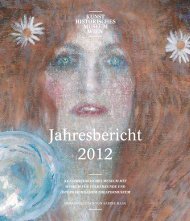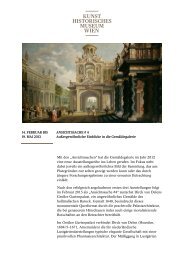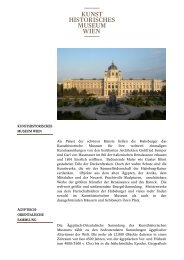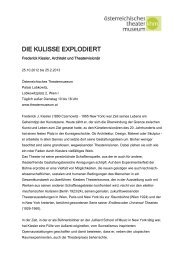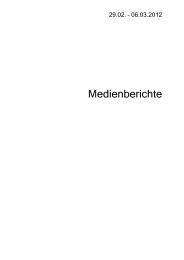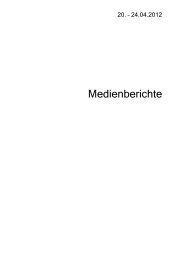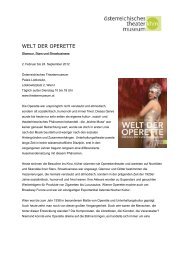Jahresbericht 2011 - Presse - Kunsthistorisches Museum Wien
Jahresbericht 2011 - Presse - Kunsthistorisches Museum Wien
Jahresbericht 2011 - Presse - Kunsthistorisches Museum Wien
Sie wollen auch ein ePaper? Erhöhen Sie die Reichweite Ihrer Titel.
YUMPU macht aus Druck-PDFs automatisch weboptimierte ePaper, die Google liebt.
Familiar & Foreign<br />
28 September to 29 February 2012<br />
Ambras castle<br />
guest presentation in ambras castle 01<br />
The Destruction of the Temple in Jerusalem<br />
by nicolas Poussin<br />
A masterpiece from the <strong>Kunsthistorisches</strong> <strong>Museum</strong><br />
30 September to 1 november <strong>2011</strong><br />
Ambras castle<br />
cultural aspects of the cultural revolution<br />
Personality cult and political design in<br />
Mao Tse-tung’s china<br />
18 February to 21 november <strong>2011</strong><br />
<strong>Museum</strong> of ethnology<br />
it proved interesting to take a look back over a few<br />
decades to a time when china was on the one hand<br />
isolated and preoccupied with itself, yet on the other<br />
hand already aroused attention throughout the world<br />
and unleashed heated debates. This period of the<br />
“cultural revolution”, the era of Mao Tse-tung, was<br />
what formed the starting point of current developments<br />
in china. Until today historians and politicians have not<br />
reached a unanimous verdict about these events. The<br />
exhibition in the <strong>Museum</strong> of ethnology aimed to make a<br />
contribution towards a better understanding of china in<br />
the 1960s and 1970s from today’s point of view and<br />
with our present-day knowledge. This analysis was of<br />
course made from a european perspective which is why<br />
it was a matter of presenting objects and documents<br />
from the period, decoding them and making them<br />
accessible and understandable for people who are interested<br />
not only in china but also in phenomena such<br />
as personality cult, mass movements, political utopias,<br />
everyday life, totalitarian propaganda and also the 1968<br />
movement in europe.<br />
The exhibition consisted primarily of items from collections<br />
which the <strong>Museum</strong> of ethnology has acquired and<br />
compiled in recent years, but also had some unusual<br />
loans from specialists and persons who experienced this<br />
period in china themselves.<br />
bali<br />
changing Art<br />
2 February to 2 May <strong>2011</strong><br />
<strong>Museum</strong> of ethnology<br />
what we see<br />
reconsidering an Anthropometrical collection from<br />
Southern Africa: images, Voices, and Versioning<br />
25 May to 19 September <strong>2011</strong><br />
<strong>Museum</strong> of ethnology<br />
locations in the wild<br />
Stage sets from three centuries<br />
26 May to 26 September <strong>2011</strong><br />
Austrian Theatre <strong>Museum</strong><br />
Forest / tree / man<br />
7 September <strong>2011</strong> to 28 May 2012<br />
<strong>Museum</strong> of ethnology<br />
scholarship as adventure<br />
etta Becker-Donner in Africa and Latin America<br />
16 november <strong>2011</strong> to 19 March 2012<br />
<strong>Museum</strong> of ethnology<br />
heinrich von kleist<br />
1777–1811<br />
20 october <strong>2011</strong> to 9 April 2012<br />
Austrian Theatre <strong>Museum</strong><br />
Kleist’s unusual and restless life led him through a restless<br />
europe. While still barely a child he was already an officer;<br />
as a student he was then older than most of his fellow<br />
students, he was a traveller, alleged or real spy, civil<br />
servant, prisoner of war, editor, political agitator, “tabloid”<br />
journalist, a non-conformist who knowingly used conventions<br />
– and above all he was a poet, in the most<br />
remarkable and most difficult conditions. in his struggle<br />
to achieve the unconditional realisation of his own<br />
standards Kleist created a literary and journalistic œuvre<br />
in a few years that now, 200 years later, is as modern as<br />
ever.<br />
19th- and 20th-century biographers saw Kleist primarily as<br />
a poet who failed because of the time in which he was<br />
living and whose life consequently had moved towards a<br />
tragic ending. nevertheless, it was not Kleist’s temporary<br />
or partial failure in himself or because of circumstances<br />
that was at the centre of the exhibition but his important<br />
and sometimes surprising decisions. His idea of a life<br />
plan can be followed up until his spectacular suicide on<br />
21 november 1811, the zenith of his self-portrayal. The<br />
leitmotif of the exhibition in Kleist Year <strong>2011</strong> was taken<br />
from Kleist’s own statements in his letters in all their<br />
contradictoriness and inner turmoil. An image was created<br />
of the poet that was complemented by digressions<br />
to some of his dramas, for instance to Käthchen von<br />
Heilbronn that was first performed on 17 March 1810 in<br />
the Theater an der <strong>Wien</strong>, and with examples of his<br />
journalistic activity as the editor of the first yellow press<br />
daily newspaper in Berlin. The exhibits on display included<br />
the autograph manuscript of Der Zerbrochene Krug, one<br />
of Kleist’s few extant original manuscripts (on loan from<br />
the Berlin State Library, Prussian cultural Heritage),<br />
valuable manuscripts from collections in Vienna and<br />
Frankfurt, and some of the rare material traces of his life.<br />
coat of dreams<br />
hungarian writers experience Vienna in<br />
the years 1873 to 1936<br />
3 March to 2 May <strong>2011</strong><br />
Austrian Theatre <strong>Museum</strong><br />
the charm of coloured shadows<br />
chinese shadow play<br />
17 november <strong>2011</strong> to 5 March 2012<br />
Austrian Theatre <strong>Museum</strong><br />
Venice<br />
maritime power, art and the carnival<br />
26 March to 6 november <strong>2011</strong><br />
Schallaburg castle, Lower Austria<br />
Imperial treasures<br />
summary<br />
Van eyck / Gossaert / Bruegel<br />
Masterpieces of the <strong>Kunsthistorisches</strong> <strong>Museum</strong> Vienna<br />
5 october <strong>2011</strong> to 15 January 2012<br />
Groeningemuseum Bruges<br />
Ivory<br />
Baroque splendour at the Viennese court<br />
3 February to 26 June <strong>2011</strong><br />
Liebieghaus collection of Sculpture<br />
Frankfurt am Main<br />
masters of Venice<br />
renaissance Painters of Passion and Power<br />
from the <strong>Kunsthistorisches</strong> <strong>Museum</strong>, Vienna<br />
29 october <strong>2011</strong> to 12 February 2012<br />
Fine Arts <strong>Museum</strong>s, San Francisco<br />
splendour & power<br />
imperial Treasures from Vienna<br />
3 December 2010 to 13 February <strong>2011</strong><br />
Schmuckmuseum Pforzheim<br />
16 April to 24 July <strong>2011</strong><br />
Stiftung Moritzburg – Kunstmuseum des<br />
Landes Sachsen-Anhalt, Halle/Saale<br />
15 August <strong>2011</strong> to15 January 2012<br />
The Fitzwilliam <strong>Museum</strong>, cambridge<br />
Indians<br />
native inhabitants of north America<br />
8 April to 6 november <strong>2011</strong><br />
Lokschuppen, rosenheim<br />
african lace<br />
A History of Trading, creativity and Fashion in nigeria<br />
3 June <strong>2011</strong> to 21 January 2012<br />
national <strong>Museum</strong>, Lagos, nigeria<br />
publIcatIons<br />
in keeping with the reputation of the <strong>Kunsthistorisches</strong><br />
<strong>Museum</strong>, some 30 independent publications present an<br />
impressive range of research-intensive activity. These include<br />
exhibition catalogues, new titles in scholarly<br />
series, books for children, special publications and collection<br />
catalogues as well as countless scholarly essays,<br />
all of which are mentioned in the present Annual report.<br />
Special mention in this regard should be made of<br />
B. Darmstädter assisted by D. Salaberger and with an<br />
essay by Bruce Dickey Die Zinken und der Serpent der<br />
Sammlung alter Musikinstrumente (collection catalogues<br />
of the KHM, edited by S. Haag, Vol. 7). The periodic<br />
series of the technology studies of the KHM: Konservierung<br />
– Restaurierung – Forschung – Technologie with<br />
sum maries in english also contributes substantially to the<br />
scholarly reputation of the institution.<br />
191




